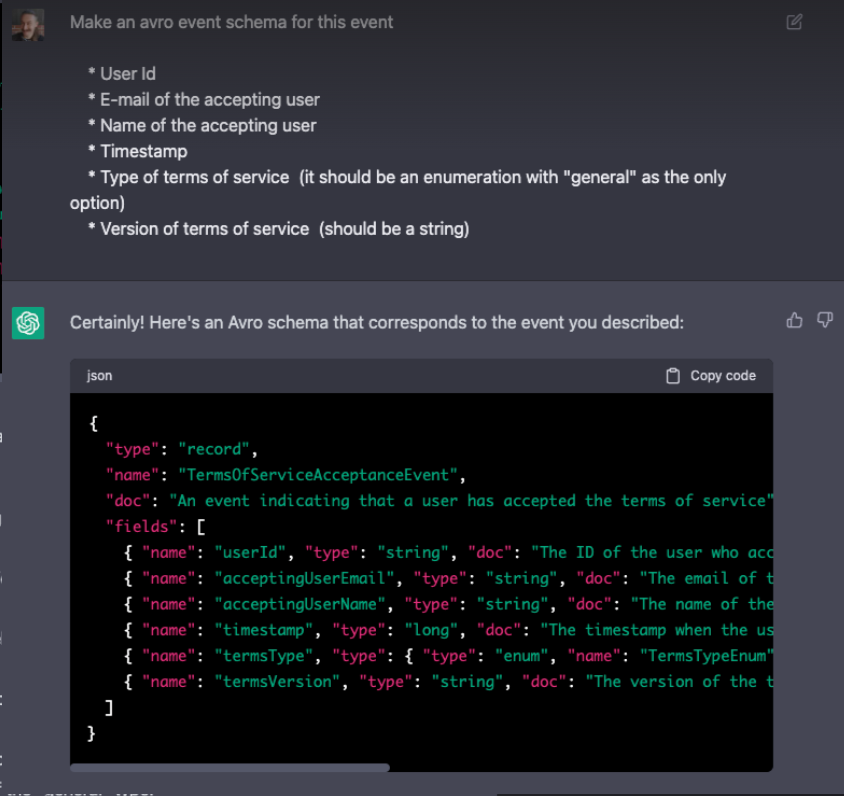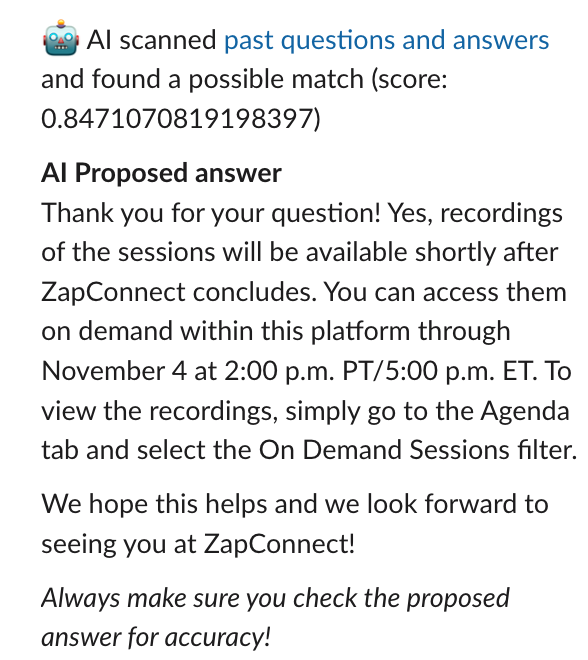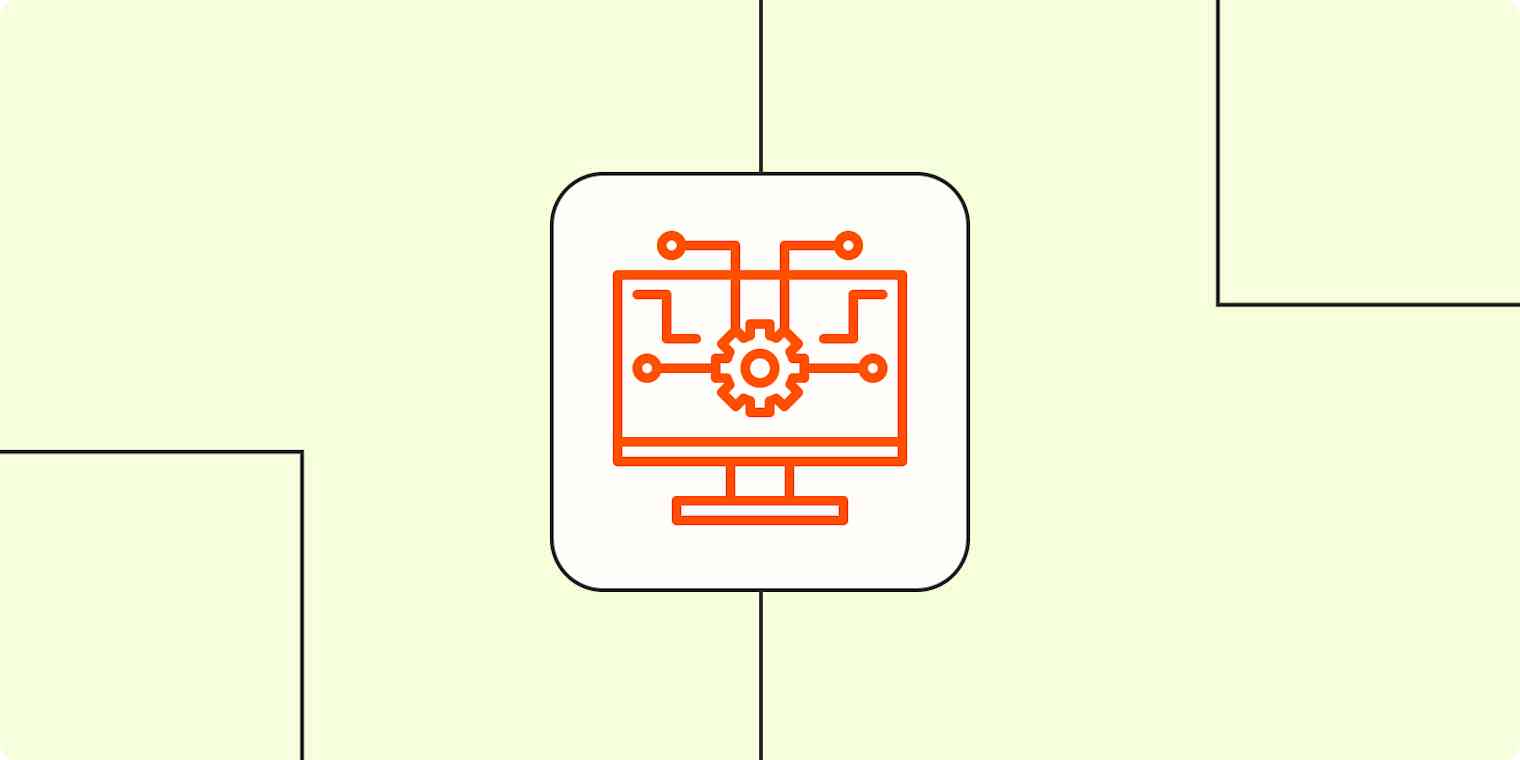Some day, we'll look back on 2023 as the year that artificial intelligence completely disrupted the way humans work. With the release of tools like ChatGPT, Google Bard, and Microsoft's new Bing, the workforce as we know it is already changing.
Yet the advent of innovative technology isn't always smooth or welcomed with open arms. The fear of being replaced by AI is very real. As a writer, I was both skeptical and a little bit afraid of AI stealing my job. So were many of my co-workers. But scary or not, it's time to embrace AI.
Of course, that's easier said than done. So I asked around Zapier to see how my colleagues are embracing—and resisting—AI and get tips on how to make AI less scary at work.
Because while it will probably change the nature of your job, AI isn't going to make you obsolete—especially if you start leveraging it now.
1. Broadcast AI far and wide
If you've used ChatGPT or Google Bard, you know that conversing with an AI chatbot is a solo experience. Good thing, too, because I can only imagine the strange things people are talking to robots about.
If you want to get your team interacting with AI at work (and don't want to bombard them with screenshots of your hilarious conversations), try pulling a chatbot into wherever your team works.
It's a great way to get first-time users playing around with it—and to uncover new use cases that will help everyone internally at work. Not only will it expose them to all the unique and creative ways everyone else is using it, but they'll also be reassured by its limitations.
For example, one product manager at Zapier created a ChatGPT bot in a public Slack channel, where anyone can go in and ask it questions. We can ask for general support when something's gone wrong, tell it to summarize text if we want a quick TLDR, or even just tell a story for entertainment's sake.

We're testing its capabilities—and laughing at its limitations—together. This helps it feel less scary while also showing off how impressive it is.
2. Remind people that AI is an underling, not an overlord
As humans, we're constantly looking for ways to make our lives easier with technology, and AI in particular. Whether it's using Alexa to set an alarm or asking Siri a question we really don't need the answer to, technology exists to assist us—and generative AI tools like ChatGPT are no different.
I spoke to a coworker at Zapier who manages multiple, complex projects on the go, and who uses AI as an assistant to streamline the process—with great results.
Before, Cody had a system where every time he received a Slack message that contained a task, he'd send that link (automatically) straight to his to-do list app using Zapier.
After experimenting with ChatGPT, he realized he could streamline things even more: AI could read the Slack message for him, then write a coherent title, description, and due date for the task, and add that to his to-do list instead. The AI can even determine the message sender's intent and only add the task to his to-do list if it determines any action is required from him. Here's the workflow, if you want to check it out.
Create Notion tasks using OpenAI with content generated from new Slack reactions
Zapier is the leader in workflow automation—integrating with 6,000+ apps from partners like Google, Salesforce, and Microsoft. Use interfaces, data tables, and logic to build secure, automated systems for your business-critical workflows across your organization's technology stack. Learn more.
Another example is moderation reporting. Zapier's Community Manager uses ChatGPT to look at queue volumes, do the math, and then tell the team in Slack how they're doing and what needs attention in the form of a quick report.

I've experienced this for myself too. As a writer, I've used AI writing tools to generate everything from landing page copy to blog post titles. The results? Mediocre at best.
But while AI may not be great at writing creative copy, I soon found a use case that worked for me. At Zapier, we tend to create a lot of Zap templates, ready-made workflows anyone can click on to automate tasks between two (or more) apps.

They're super handy (for both us and our customers), but writing those titles and descriptions takes time—and when you're building lots of them, it can get a tad tedious. It turns out, AI is good at churning out (mostly) perfect product descriptions.
We still need to occasionally tweak a couple of things and adapt it to our style guide, but its accuracy and the ability to scale faster is pretty remarkable. And my guess is it will only get better at it as time goes on.
In the end, encouraging your team to incorporate AI into their admin tasks serves as a reminder that AI tools are our robot underlings, not our robot overlords.
3. Incorporate it into existing work
Given that everyone's worried about robots taking their jobs, I never thought AI would actually give people a confidence boost about their abilities—but that's exactly what happened here at Zapier.
Here's why: AI tools like ChatGPT are clever, but they can't be considered a single source of truth in highly specialized areas. In fact, get them to try to do your job, and they usually do it…fine? But not as good as you—not by a long shot.
One engineer I spoke to at Zapier said he used both ChatGPT and GitHub Copilot to handle rote tasks, like asking documentation questions, suggesting improvements to existing code, and creating boilerplate code for certain situations.

But he said that, in a weird way, using AI to code has made him more confident and comfortable as a programmer: it's helped him overcome the malaise of writing boilerplate copy, while also allowing him to focus on the parts of engineering that truly excite and matter to him—the parts that require human interaction.
I also spoke to Deb, one of Zapier's blog editors, who used ChatGPT to see if it could help her write email copy. But the editing involved ended up taking her significantly longer than had she just written the copy herself.
Despite this, Deb's experience of refining the prompts she provided to the AI turned out to be an exercise in learning more about how AI works, and also prompted her to reflect on the core objectives of the newsletter she was writing. Was the goal to succinctly summarize articles? Or was it to offer fresh insights? Or something else entirely?
By asking AI to do your actual job for you, your teammates will hopefully realize that humans are (usually) better than it—but they'll also start to see its benefits and figure out how they can use it in other aspects of their role.
4. Frame AI as a draft-maker, not a decision-maker
I wouldn't trust AI to write and send an email on my behalf without first checking it—and that applies to any sort of output the AI gives.
You should make this very clear to your team: AI should not be used without human oversight. And not just because of ethical and legal concerns—also because, at the end of the day, AI lacks contextual understanding.
Take our Events team at Zapier. They receive a lot of emails from people who have questions about specific events they're hosting. The team decided to experiment with AI to help them manage that workload. They set up a workflow where the AI takes support questions from incoming emails, then runs them through a list of common questions and answers to see if there's a match.
If it finds a match to the question, the AI will draft a written email response the events team can check—and they can decide whether they'll send it.

Their hope is that whenever big events are coming up, the team can move quickly and get those emails drafted automatically. But drafted is the key word.
Encouraging your team to use AI in the same way to draft ticket replies, standard business emails, and other customer communication will help them see that human supervision is a must.
The best way to stop being afraid of AI? Use AI.
Everyone I spoke to at Zapier was either impressed with the way AI can help them do their jobs better or reassured that it wasn't as good in their expert areas as the hype would make it seem.
Either way, you need to get folks on board with using it. They might be surprised (and relieved) by the results.
Related reading:





